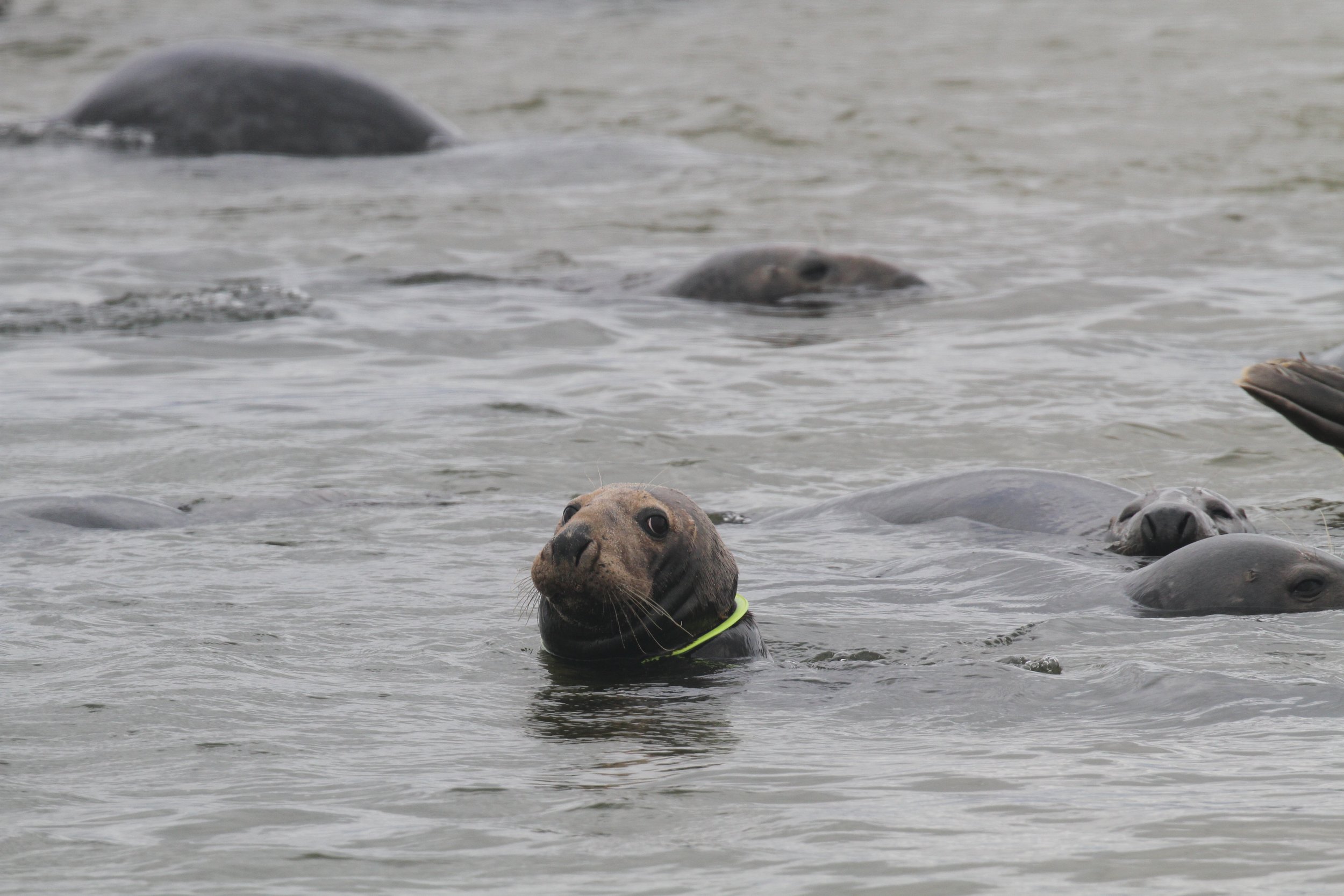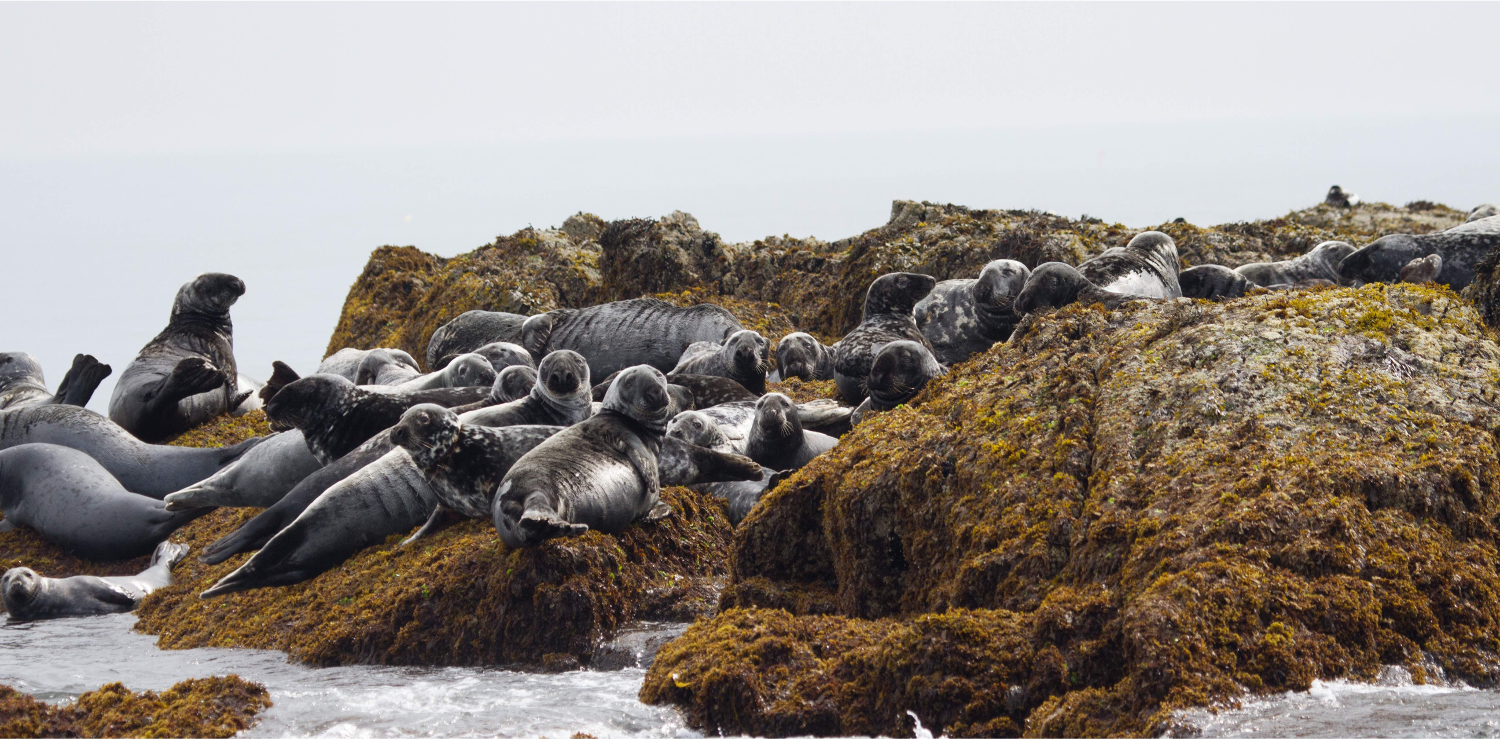
Swimming in a Human-Impacted Ocean

Living at the edge of land & sea, seals tell us so much about old threats and new threats to humans, seals and all beings in our ecosystem, if we choose to listen.
Seals are Sentinels of Ocean and Human Health.
Sentinel:
Noun
1.a person or thing that watches or stands as if watching.
2. a soldier stationed as a guard to challenge all comers and prevent a surprise attack: to stand sentinel.
Entanglement
Propellers
Plastics
Climate Change
“Entanglement” means any material wrapped around an animal’s body that they can’t get free of. Sometimes, it’s fishing gear, sometimes it’s litter like packing straps or even toys. Entanglements can harm seals in several ways: they can interfere with a seal’s ability to swim and forage, cause infection, and kill seals by drowning or blood loss. It is very difficult to get an entangled seal free, in no small part because the seal often is not easily approached. The Marine Mammal Rescue and Research team for IFAW (the International Fund for Animal Welfare) is one of the organizations trained to help injured seals in New England. IFAW responds to marine mammals on Cape Cod and Southeastern MA.
If you see an entangled or injured seal anywhere, don’t touch or disturb it. Call the people trained to help: your local marine mammal stranding network.
Not sure if the seal is injured? Call anyway! The people answering the phone will be able to talk you through and assess the situation: In the Greater Atlantic Region, call the NOAA Fisheries 24-hour Stranding Hotline: (866) 755-6622.
For More information about injured, entangled, stranded marine mammals, visit their website at: MARINE LIFE IN DISTRESS.
Pollutants
Entanglement & Boat Strikes
Researchers use video and photographs, like the one above, taken from satellites, planes, and drones to document and count seals, including those living with entanglements or other injuries.
Over 2,000 gray and harbor seals are mistakenly caught as “bycatch” every year in the northeast sink gill net fishery, and many more are living with entanglements. This is more than the number of seals hunted per year during the bounties of the 1880s-1960 in New England. No one wants to have bycatch happen.
So, What can we do to change this?
Understanding the extent of entanglements is the first step. Studies utilizing new and old technologies, from standard DSLR cameras in hand to high tech unmanned aerial vehicles (drones), have gathered and are gathering data. This work will both lead to a clearer understanding of where entanglements occur as well as how many animals are affected- and hopefully, how to prevent entanglements from happening.
Scientists and fishermen are also working together using cameras to understand how these interactions are happening underwater—and then, possibly, ways to address the issue that benefits both seals and people.
Please note: personal drone photography can disturb marine mammals, and this violates the Marine Mammal Protection Act. Drones are not permitted in many national parks. The photos on this site were taken under research permits and with care to not disturb the animals below. (Read more about the guidelines on NOAA’s site.)
Climate Change
When you think of climate change, most often people tend to think of icy frigid locations like the Arctic. But did you know, The Gulf of Maine, the body of water right off the northeast US, is the fastest warming body of ocean water on earth?
Seals (not just those in the Arctic) are increasingly being affected by climate change.
Warming waters are changing where their prey go, where they can breed and rest, how diseases spread, where and when harmful algal blooms occur, as well as where and how seals interact with human activities.
August 8, 2018. NASA Earth Observatory images by Lauren Dauphin, and sea surface temperature data from Coral Reef Watch. Notice how “hot” the Gulf of Maine is in 2018.
Pollutants and Plastics
Did you know that pollutants, including plastics, can remain in our oceans for thousands of years!?
Some chemicals that are known to be harmful were successfully banned decades ago, like DDT and PCBs (polychlorinated biphenyls), but still persist in our environment AND in animals, including seals today.
Some chemicals are still being used and produced. Many people are interested in finding out more about how they might affect wildlife and people. These include chemicals used to fight or prevent fire, called flame retardants (PBDEs) or are used and found in various aspects of the textile industry (PFAS). Chemicals are also found in the breakdown products of plastics as they decay and find their way into seals through food, including mother’s milk.
Measuring Brominated flame retardants in Seals as they transfer from mom to pup. (Berger et al. 2023)
Researchers have even found micro-plastics in the scat of seals and fur seals!
References
Murray, K. T., Hatch, J. M., DiGiovanni Jr, R. A., & Josephson, E. (2021). Tracking young-of-the-year gray seals Halichoerus grypus to estimate fishery encounter risk. Marine Ecology Progress Series, 671, 235-245.
Lelli, B., Harris, D. E., & Aboueissa, A. M. (2009). Seal bounties in Maine and Massachusetts, 1888 to 1962. Northeastern Naturalist, 16(2), 239-254.
Michelle L. Berger, Susan D. Shaw, Charles Rolsky, Jennifer H. Harris, Ying Guo, Kurunthachalam Kannan, Occurrence and tissue-specific partitioning of alternative brominated flame retardants in northwest Atlantic harbor seal pups (Phoca vitulina vitulina), Chemosphere, Volume 318, 2023









